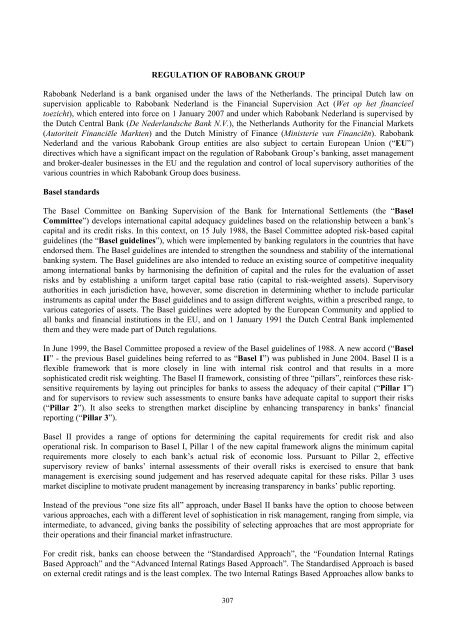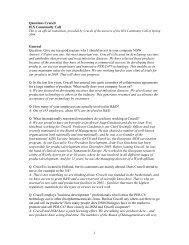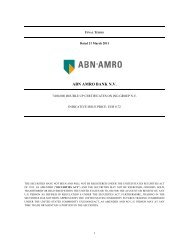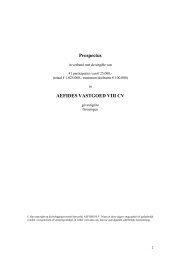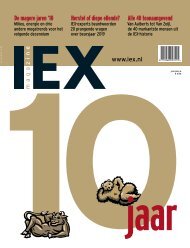Dit prospectus is gemaakt voor de uitgifte van dit product en ... - Iex
Dit prospectus is gemaakt voor de uitgifte van dit product en ... - Iex
Dit prospectus is gemaakt voor de uitgifte van dit product en ... - Iex
Create successful ePaper yourself
Turn your PDF publications into a flip-book with our unique Google optimized e-Paper software.
REGULATION OF RABOBANK GROUPRabobank Ne<strong>de</strong>rland <strong>is</strong> a bank organ<strong>is</strong>ed un<strong>de</strong>r the laws of the Netherlands. The principal Dutch law onsuperv<strong>is</strong>ion applicable to Rabobank Ne<strong>de</strong>rland <strong>is</strong> the Financial Superv<strong>is</strong>ion Act (Wet op het financieeltoezicht), which <strong>en</strong>tered into force on 1 January 2007 and un<strong>de</strong>r which Rabobank Ne<strong>de</strong>rland <strong>is</strong> superv<strong>is</strong>ed bythe Dutch C<strong>en</strong>tral Bank (De Ne<strong>de</strong>rlandsche Bank N.V.), the Netherlands Authority for the Financial Markets(Autoriteit Financiële Markt<strong>en</strong>) and the Dutch Min<strong>is</strong>try of Finance (Min<strong>is</strong>terie <strong>van</strong> Financiën). RabobankNe<strong>de</strong>rland and the various Rabobank Group <strong>en</strong>tities are also subject to certain European Union (“EU”)directives which have a significant impact on the regulation of Rabobank Group’s banking, asset managem<strong>en</strong>tand broker-<strong>de</strong>aler businesses in the EU and the regulation and control of local superv<strong>is</strong>ory authorities of thevarious countries in which Rabobank Group does business.Basel standardsThe Basel Committee on Banking Superv<strong>is</strong>ion of the Bank for International Settlem<strong>en</strong>ts (the “BaselCommittee”) <strong>de</strong>velops international capital a<strong>de</strong>quacy gui<strong>de</strong>lines based on the relationship betwe<strong>en</strong> a bank’scapital and its cre<strong>dit</strong> r<strong>is</strong>ks. In th<strong>is</strong> context, on 15 July 1988, the Basel Committee adopted r<strong>is</strong>k-based capitalgui<strong>de</strong>lines (the “Basel gui<strong>de</strong>lines”), which were implem<strong>en</strong>ted by banking regulators in the countries that have<strong>en</strong>dorsed them. The Basel gui<strong>de</strong>lines are int<strong>en</strong><strong>de</strong>d to str<strong>en</strong>gth<strong>en</strong> the soundness and stability of the internationalbanking system. The Basel gui<strong>de</strong>lines are also int<strong>en</strong><strong>de</strong>d to reduce an ex<strong>is</strong>ting source of competitive inequalityamong international banks by harmon<strong>is</strong>ing the <strong>de</strong>finition of capital and the rules for the evaluation of assetr<strong>is</strong>ks and by establ<strong>is</strong>hing a uniform target capital base ratio (capital to r<strong>is</strong>k-weighted assets). Superv<strong>is</strong>oryauthorities in each jur<strong>is</strong>diction have, however, some d<strong>is</strong>cretion in <strong>de</strong>termining whether to inclu<strong>de</strong> particularinstrum<strong>en</strong>ts as capital un<strong>de</strong>r the Basel gui<strong>de</strong>lines and to assign differ<strong>en</strong>t weights, within a prescribed range, tovarious categories of assets. The Basel gui<strong>de</strong>lines were adopted by the European Community and applied toall banks and financial institutions in the EU, and on 1 January 1991 the Dutch C<strong>en</strong>tral Bank implem<strong>en</strong>tedthem and they were ma<strong>de</strong> part of Dutch regulations.In June 1999, the Basel Committee proposed a review of the Basel gui<strong>de</strong>lines of 1988. A new accord (“BaselII” - the previous Basel gui<strong>de</strong>lines being referred to as “Basel I”) was publ<strong>is</strong>hed in June 2004. Basel II <strong>is</strong> aflexible framework that <strong>is</strong> more closely in line with internal r<strong>is</strong>k control and that results in a moresoph<strong>is</strong>ticated cre<strong>dit</strong> r<strong>is</strong>k weighting. The Basel II framework, cons<strong>is</strong>ting of three “pillars”, reinforces these r<strong>is</strong>ks<strong>en</strong>sitiverequirem<strong>en</strong>ts by laying out principles for banks to assess the a<strong>de</strong>quacy of their capital (“Pillar 1”)and for superv<strong>is</strong>ors to review such assessm<strong>en</strong>ts to <strong>en</strong>sure banks have a<strong>de</strong>quate capital to support their r<strong>is</strong>ks(“Pillar 2”). It also seeks to str<strong>en</strong>gth<strong>en</strong> market d<strong>is</strong>cipline by <strong>en</strong>hancing transpar<strong>en</strong>cy in banks’ financialreporting (“Pillar 3”).Basel II provi<strong>de</strong>s a range of options for <strong>de</strong>termining the capital requirem<strong>en</strong>ts for cre<strong>dit</strong> r<strong>is</strong>k and alsooperational r<strong>is</strong>k. In compar<strong>is</strong>on to Basel I, Pillar 1 of the new capital framework aligns the minimum capitalrequirem<strong>en</strong>ts more closely to each bank’s actual r<strong>is</strong>k of economic loss. Pursuant to Pillar 2, effectivesuperv<strong>is</strong>ory review of banks’ internal assessm<strong>en</strong>ts of their overall r<strong>is</strong>ks <strong>is</strong> exerc<strong>is</strong>ed to <strong>en</strong>sure that bankmanagem<strong>en</strong>t <strong>is</strong> exerc<strong>is</strong>ing sound judgem<strong>en</strong>t and has reserved a<strong>de</strong>quate capital for these r<strong>is</strong>ks. Pillar 3 usesmarket d<strong>is</strong>cipline to motivate pru<strong>de</strong>nt managem<strong>en</strong>t by increasing transpar<strong>en</strong>cy in banks’ public reporting.Instead of the previous “one size fits all” approach, un<strong>de</strong>r Basel II banks have the option to choose betwe<strong>en</strong>various approaches, each with a differ<strong>en</strong>t level of soph<strong>is</strong>tication in r<strong>is</strong>k managem<strong>en</strong>t, ranging from simple, viaintermediate, to ad<strong>van</strong>ced, giving banks the possibility of selecting approaches that are most appropriate fortheir operations and their financial market infrastructure.For cre<strong>dit</strong> r<strong>is</strong>k, banks can choose betwe<strong>en</strong> the “Standard<strong>is</strong>ed Approach”, the “Foundation Internal RatingsBased Approach” and the “Ad<strong>van</strong>ced Internal Ratings Based Approach”. The Standard<strong>is</strong>ed Approach <strong>is</strong> basedon external cre<strong>dit</strong> ratings and <strong>is</strong> the least complex. The two Internal Ratings Based Approaches allow banks to307


